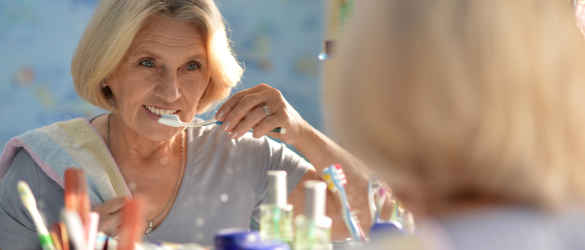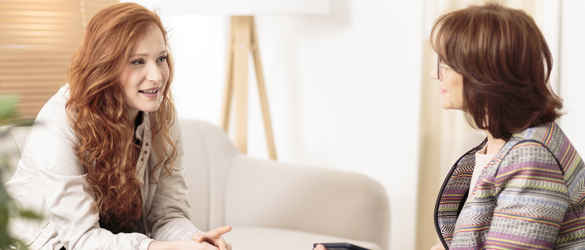
Lighting
At home
Good lighting at home is important, particularly if you have poor vision. Light becomes more important for all of us as we age. By the age of 60 we need three times more light than in our twenties.
If you add a sight loss condition to this the figure can double.
So a 60-year-old with sight loss will need approximately six times more light than a sighted 20-year-old.
There are three types of lighting: Natural daylight, general lighting and task lighting.
Natural daylight
Make the most of natural daylight, while controlling glare.
- Open curtains wide and keep windows clean.
- Remove net curtains.
- Use vertical blinds, not horizontal. They’re easier to control light levels and enable you to change the direction of light coming into the room.
- Roller blinds can help you control the amount of light coming in and prevent it shining in your eyes.
- Blue blocker filter lenses in glasses can improve contrast and reduce glare.
General lighting
General lighting needs to be bright and even and not cause glare.
- Try to make the lighting similar in all rooms so that you don’t have to adjust to new light levels as you move about the home.
- Stay safe by keeping halls and stairs well-lit.
- Leaving hall lights on can help you move safely around the home at night.
- Use colour and contrast for light switches to make them stand out.
- Paint walls in matt pale colours to reflect light into a room.
Task lighting
Extra lighting is needed for activities like reading, preparing food or other close work.
Effective task lighting can really help. It can:
- be helpful in the kitchen. Under-cupboard lighting can be very effective for lighting work surfaces
- make reading easier by improving the contrast of text on the page
- make it easier to identify colours
- help to break through mistiness in vision reduce the amount of magnification needed.
Task lamps need to be positioned below eye level, shining onto the task, not into your eyes.
They should be stable to avoid getting knocked over, and bulbs should stay cool to avoid discomfort or even burning yourself.
When buying a task lamp consider:
- What activities do you want it for?
- Would a table-top, floor-standing or wall-mounted one be best?
- How easy is it to adjust its position to get the light where you need it?
- Does the shade stop the light shining directly into your eyes when the lamp is positioned below eye level?
The amount of light needed varies from person to person. To find the right level for you, start with the task light further away from the object you need to see and then move it closer slowly until you find the amount of illumination comfortable for you.
Halving the distance between an object and the light will create 4 times more light on the object.
If you are using a magnifier with a task lamp, keep the magnifier parallel to the light so that you look through it onto a well-lit object. Don’t put the magnifier under the light because this causes annoying reflections and pools of light on the object.
Keep some background light on when using task lighting to reduce glare and fatigue.
Tips for effective lighting
- Have several lights in a room rather than one bright light and position them to get an even spread of light with no dark corners.
- Shade bulbs so that they do not shine into your eyes. Check the maximum bulb rating for light shades to make sure you use the correct bulbs.
- Round paper shades are good at diffusing light in the room. Avoid using lampshades or spotlights where you can see the bulb.
- Use uplighters to bounce light onto the ceiling and back into the room.
- Spotlights are effective for lighting specific areas in a well-lit room but can cause confusing bright and dark patches and glare if used in isolation.
- Dimmer systems can be used to vary the amount of light needed.
Video: The importance of good lighting
The video below provides tips on how you can make the best use of lighting in your house.
Light bulbs
Traditional tungsten light bulbs have been phased out because they get hot and use a lot of energy. New low-energy efficient bulbs get bright very quickly, are cost efficient to run and come in a range of brightness levels, shapes and fittings.
Types of light bulbs
- Light Emitting Diodes (LEDs) offer instant crisp, bright light. They tend to be more expensive than other products but can save money as they are long-life and energy efficient.
- Compact fluorescent bulbs (CFLs) are fluorescent tubes curved or folded into various shapes and compact enough to suit a range of light fittings. They are energy efficient and long-life bulbs. They may take time to reach full brightness but there are ‘quick start’ products that warm up faster. Unfortunately most CFLs can’t be used with standard dimmer switches.
- Fluorescent tubes produce less heat and use less energy. A single long straight type of this bulb is often used in the kitchen. Replacing these with multiple lights will provide more even light.
- LED lights are now available as a ‘bulb’ version or in a ‘strip’ light format similar to the traditional CFL strip light.
- Halogen lighting produces a very bright, light but gets extremely hot. Avoid the narrow beam spotlights. Be careful when changing halogen bulbs; use a cloth – the natural oil on skin will damage the bulb. Halogen lighting is cheap and provides instant brightness but isn’t as energy efficient as CFLs or LEDs.
The brightness of the bulb is measured in Lumens. The higher the Lumen the brighter the light.
Colour temperature
Light bulbs come in a variety of colours, or light temperature. This is measured in Kelvin. The lower the K, the warmer or yellower the light will appear: the higher the K the cooler or whiter the light will appear.
For areas where ambience is the priority, such as living rooms and dining rooms, warmer light temperatures are often preferred. Where function is the priority, choose higher light temperatures instead.
Light Bulb Ratings
An old 60W bulb is roughly equivalent to a:
- 15W CFL (compact fluorescent tube)
- an 8W LED (light emitting diode)
- and around 800 Lumens (lumen is an indicator of brightness).
An old 100W bulb is roughly equivalent to a:
- 27W CFL
- an 18W LED
- and around 1550 Lumens
Want more information or have questions?
Call the Macular Society Helpline on 0300 3030 111 or email help@macularsociety.org
Around the home
Feel more independent in your home with our practical guides to everyday activities such as preparing meals, personal care, using technology and more.
Support for you
We provide free information and support to those with macular disease, along with their family and friends, to help people keep their independence.
Get the latest news and advice from the Macular Society
To hear about life-changing research, treatments and tips for living with sight loss, subscribe to our monthly enewsletter today. Together we can Beat Macular Disease.
Sign up to our free email newsletter



